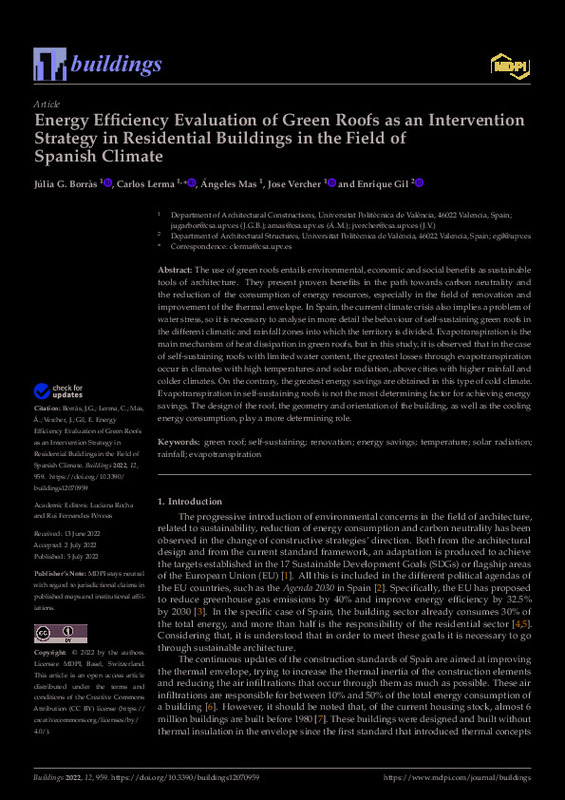JavaScript is disabled for your browser. Some features of this site may not work without it.
Buscar en RiuNet
Listar
Mi cuenta
Estadísticas
Ayuda RiuNet
Admin. UPV
Energy Efficiency Evaluation of Green Roofs as an Intervention Strategy in Residential Buildings in the Field of Spanish Climate
Mostrar el registro sencillo del ítem
Ficheros en el ítem
| dc.contributor.author | Garcia-Borràs, Júlia
|
es_ES |
| dc.contributor.author | Lerma Elvira, Carlos
|
es_ES |
| dc.contributor.author | Mas Tomas, Maria De Los Angeles
|
es_ES |
| dc.contributor.author | Vercher Sanchis, José
|
es_ES |
| dc.contributor.author | Gil Benso, Enrique
|
es_ES |
| dc.date.accessioned | 2023-05-12T18:02:09Z | |
| dc.date.available | 2023-05-12T18:02:09Z | |
| dc.date.issued | 2022-07 | es_ES |
| dc.identifier.issn | 2075-5309 | es_ES |
| dc.identifier.uri | http://hdl.handle.net/10251/193330 | |
| dc.description.abstract | [EN] The use of green roofs entails environmental, economic and social benefits as sustainable tools of architecture. They present proven benefits in the path towards carbon neutrality and the reduction of the consumption of energy resources, especially in the field of renovation and improvement of the thermal envelope. In Spain, the current climate crisis also implies a problem of water stress, so it is necessary to analyse in more detail the behaviour of self-sustaining green roofs in the different climatic and rainfall zones into which the territory is divided. Evapotranspiration is the main mechanism of heat dissipation in green roofs, but in this study, it is observed that in the case of self-sustaining roofs with limited water content, the greatest losses through evapotranspiration occur in climates with high temperatures and solar radiation, above cities with higher rainfall and colder climates. On the contrary, the greatest energy savings are obtained in this type of cold climate. Evapotranspiration in self-sustaining roofs is not the most determining factor for achieving energy savings. The design of the roof, the geometry and orientation of the building, as well as the cooling energy consumption, play a more determining role. | es_ES |
| dc.language | Inglés | es_ES |
| dc.publisher | MDPI AG | es_ES |
| dc.relation.ispartof | Buildings | es_ES |
| dc.rights | Reconocimiento (by) | es_ES |
| dc.subject | Green roof | es_ES |
| dc.subject | Self-sustaining | es_ES |
| dc.subject | Renovation | es_ES |
| dc.subject | Energy savings | es_ES |
| dc.subject | Temperature | es_ES |
| dc.subject | Solar radiation | es_ES |
| dc.subject | Rainfall | es_ES |
| dc.subject | Evapotranspiration | es_ES |
| dc.subject.classification | CONSTRUCCIONES ARQUITECTONICAS | es_ES |
| dc.subject.classification | MECANICA DE LOS MEDIOS CONTINUOS Y TEORIA DE ESTRUCTURAS | es_ES |
| dc.title | Energy Efficiency Evaluation of Green Roofs as an Intervention Strategy in Residential Buildings in the Field of Spanish Climate | es_ES |
| dc.type | Artículo | es_ES |
| dc.identifier.doi | 10.3390/buildings12070959 | es_ES |
| dc.relation.projectID | info:eu-repo/grantAgreement/UPV-VIN//PAID-01-19-10//Estudio hidrotérmico de cubiertas ajardinadas. Análisis y recomendaciones de diseño para una mayor eficiencia energética./ | es_ES |
| dc.rights.accessRights | Abierto | es_ES |
| dc.contributor.affiliation | Universitat Politècnica de València. Departamento de Construcciones Arquitectónicas - Departament de Construccions Arquitectòniques | es_ES |
| dc.contributor.affiliation | Universitat Politècnica de València. Escuela Técnica Superior de Arquitectura - Escola Tècnica Superior d'Arquitectura | es_ES |
| dc.description.bibliographicCitation | Garcia-Borràs, J.; Lerma Elvira, C.; Mas Tomas, MDLA.; Vercher Sanchis, J.; Gil Benso, E. (2022). Energy Efficiency Evaluation of Green Roofs as an Intervention Strategy in Residential Buildings in the Field of Spanish Climate. Buildings. 12(7):1-17. https://doi.org/10.3390/buildings12070959 | es_ES |
| dc.description.accrualMethod | S | es_ES |
| dc.relation.publisherversion | https://doi.org/10.3390/buildings12070959 | es_ES |
| dc.description.upvformatpinicio | 1 | es_ES |
| dc.description.upvformatpfin | 17 | es_ES |
| dc.type.version | info:eu-repo/semantics/publishedVersion | es_ES |
| dc.description.volume | 12 | es_ES |
| dc.description.issue | 7 | es_ES |
| dc.relation.pasarela | S\468548 | es_ES |
| dc.contributor.funder | UNIVERSIDAD POLITECNICA DE VALENCIA | es_ES |
| dc.subject.ods | 11.- Conseguir que las ciudades y los asentamientos humanos sean inclusivos, seguros, resilientes y sostenibles | es_ES |
| dc.subject.ods | 13.- Tomar medidas urgentes para combatir el cambio climático y sus efectos | es_ES |








